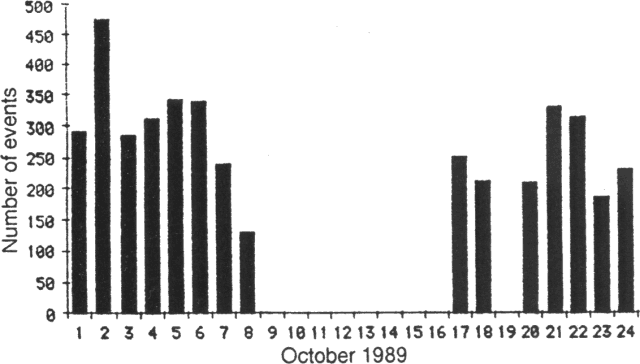Report on Poas (Costa Rica) — October 1989
Scientific Event Alert Network Bulletin, vol. 14, no. 10 (October 1989)
Managing Editor: Lindsay McClelland.
Poas (Costa Rica) Continued thermal activity from crater lake; sulfur flows
Please cite this report as:
Global Volcanism Program, 1989. Report on Poas (Costa Rica) (McClelland, L., ed.). Scientific Event Alert Network Bulletin, 14:10. Smithsonian Institution. https://doi.org/10.5479/si.GVP.SEAN198910-345040
Poas
Costa Rica
10.2°N, 84.233°W; summit elev. 2697 m
All times are local (unless otherwise noted)
Thermal activity continued, with the same characteristics as in previous months. The level of the hot crater lake varied. Its water contained a high concentration of mud and sulfur as yellow scum in suspension. Thixotropic mud on the surrounding terraces maintained temperatures of 30-40°C. Small fumaroles around the lake had a maximum temperature of 92°C. The hot area in the SE quadrant persisted, with mud and sulfur cones, patches of mud, and fumaroles (figure 23, top). All of the N sector contained castle-like features and cones of mud and sulfur, while a molten sulfur lake was the source of occasional flows several meters long and a few centimeters thick (figure 23, center and bottom). Fumaroles on the remnants of the 1953-55 [dome] emitted water-dominated vapor in equilibrium with the surrounding atmosphere; temperatures varied between 60° and 92°C. Volcanic microseismicity totaled 4,163 events for a daily mean of 278 during the 15 days that station VPS-2 was operational (figure 24). Almost 500 microearthquakes were recorded on the 2nd.
 |
Figure 24. Number of seismic events/day recorded 1-8, 17-18, and 20-24 October 1989 by station VPS-2. Courtesy of Mario Fernández. |
Geological Summary. The broad vegetated edifice of Poás, one of the most active volcanoes of Costa Rica, contains three craters along a N-S line. The frequently visited multi-hued summit crater lakes of the basaltic-to-dacitic volcano are easily accessible by vehicle from the nearby capital city of San José. A N-S-trending fissure cutting the complex stratovolcano extends to the lower N flank, where it has produced the Congo stratovolcano and several lake-filled maars. The southernmost of the two summit crater lakes, Botos, last erupted about 7,500 years ago. The more prominent geothermally heated northern lake, Laguna Caliente, is one of the world's most acidic natural lakes, with a pH of near zero. It has been the site of frequent phreatic and phreatomagmatic eruptions since an eruption was reported in 1828. Eruptions often include geyser-like ejections of crater-lake water.
Information Contacts: G. Soto, Mario Fernández, and Héctor Flores, Univ de Costa Rica.


